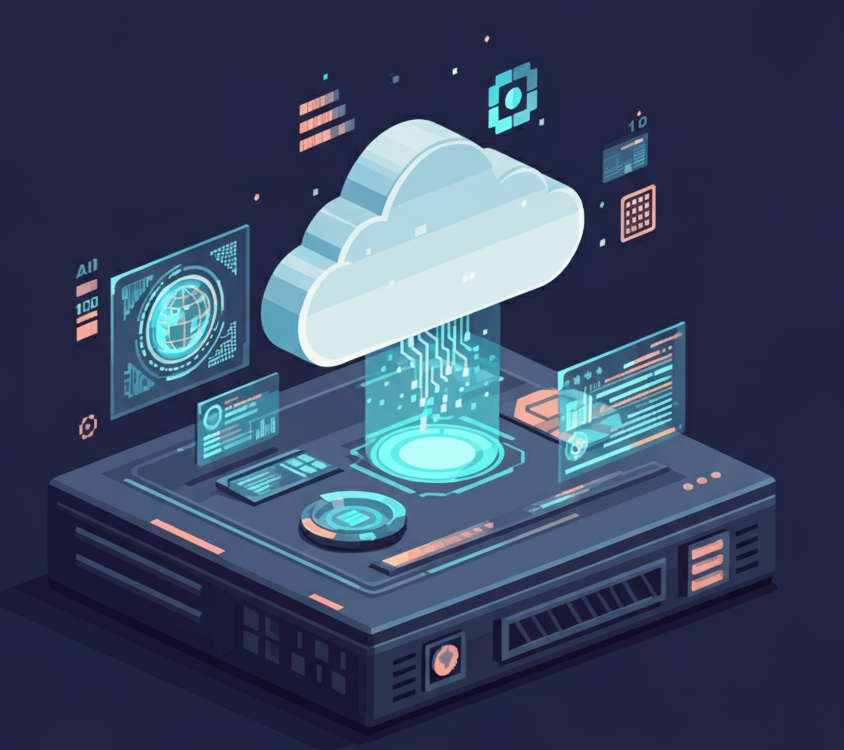Artificial Intelligence (AI) and cloud software are reshaping the technological landscape. But are cloud solutions ready to fully leverage AI’s power? The short answer is yes, and here’s why.
The Convergence of AI and Cloud Computing
The integration of AI into cloud platforms is not just a possibility but a reality that promises to revolutionize business operations. AI technologies thrive on vast amounts of data and computational power, which are inherently provided by cloud infrastructure.
Enhanced Data Management Capabilities
The scalability and flexibility of cloud platforms extend to data management, facilitating efficient handling of vast datasets essential for AI applications. Cloud services offer scalable data storage solutions on demand, ensuring that companies can store tremendous amounts of structured and unstructured data without facing capacity constraints. Additionally, these platforms provide advanced data integration tools that facilitate seamless data ingestion from various sources, allowing businesses to maintain a centralized data repository easily.

Furthermore, cloud platforms’ flexibility ensures that data can be accessed and processed in real-time, which is critical for AI-driven analytics and insights. Whether through serverless architectures, containerization, or managed services, cloud providers offer flexible deployment models that can adapt to an organization’s specific data processing needs. This adaptability accelerates the development and deployment of AI models, making it easier for businesses to experiment with innovative solutions and bring them to market rapidly.
In summary, cloud platforms’ enhanced data management capabilities are crucial for meeting the demands of AI workloads. They ensure that data scalability and flexibility are not hindrances but facilitators in harnessing artificial intelligence’s full potential.
Cost Efficiency of Cloud Software
One significant benefit of cloud computing is cost efficiency. Traditional on-site solutions require substantial investments in hardware and maintenance. In contrast, cloud services operate on a pay-as-you-go model, which is particularly advantageous for AI development, where computational needs can vary dramatically.
According to a Gartner 2021 report, organizations that migrate to cloud infrastructure can expect to save an average of 20% on their IT costs. This cost-saving is primarily because cloud providers manage the underlying hardware and maintenance, reducing capital expenditure. Moreover, cloud platforms enable businesses to scale their AI workloads up or down based on demand, ensuring they only pay for the resources they use.
For instance, companies utilizing Amazon Web Services (AWS) can use services like Amazon EC2 Spot Instances, which allow access to spare compute capacity at discounts of up to 90% compared to on-demand prices. Such flexible pricing models result in significant cost reductions, particularly for AI projects that require extensive computational resources for a limited period. Google Cloud and Microsoft Azure offer similar cost optimization features through their respective Preemptible VMs and Azure Spot Virtual Machines.
The cost advantages extend beyond mere computational power. Once a heavily expensive component of IT budgets, data storage becomes much more affordable through cloud services. According to IDC‘s 2020 survey, companies reduced their data storage costs by an average of 30% after moving to cloud solutions. This cost efficiency ensures organizations can allocate more resources to innovation and AI-driven research rather than being bogged down by prohibitive infrastructure expenses.
In summary, cloud computing’s cost efficiency significantly benefits AI development by reducing capital and operational expenditures. The pay-as-you-go model and flexible pricing options make it economically feasible for businesses to experiment, scale, and innovate without the massive financial overhead typically associated with on-premises IT infrastructure.
Advanced Tools and Services of Cloud Software
Leading cloud providers offer a suite of AI and machine learning tools to streamline development. These include pre-trained models, APIs for natural language processing (NLP), image recognition, and more. For instance, AWS SageMaker, Azure Machine Learning, and Google AI Platform empower developers to build, train, and deploy AI models with greater ease and speed.

In 2022, AWS reported SageMaker facilitated a 54% reduction in the time required to develop and deploy machine learning models compared to traditional methods. This efficiency gain is attributed to SageMaker’s robust tools, such as built-in algorithms, automated model tuning, and one-click deployment capabilities. SageMaker also offers integration with other AWS services, ensuring a seamless workflow from data preparation to model deployment and monitoring.
On the other hand, Azure Machine Learning provides automated machine learning (AutoML) capabilities that significantly reduce manual effort. According to Microsoft’s studies, utilizing AutoML reduced the time spent in model selection and hyperparameter tuning by up to 70%. This tool also offers interpretability features crucial for ensuring that AI models are transparent and that non-technical stakeholders can understand their predictions.
Google AI Platform offers a comprehensive ecosystem for AI development, including TensorFlow, a popular open-source machine learning library. Google’s internal surveys indicate that integrating TensorFlow with the Google AI Platform led to productivity improvements of up to 40% for data scientists. Additionally, the Google AI Platform provides tools for continuous evaluation and retraining of models, ensuring that deployed models maintain high accuracy over time as new data becomes available.
These advanced tools and services offered by cloud providers not only enhance productivity but also lower the barrier to entry for AI development. Businesses can leverage pre-built components and scalable infrastructure to accelerate their AI initiatives, ultimately driving innovation and competitive advantage. The availability of such powerful yet user-friendly tools democratizes AI, enabling organizations of various sizes and industries to harness the transformative power of artificial intelligence.
Real-World Applications of Cloud Software
Healthcare
In healthcare, AI-powered cloud solutions revolutionize patient care and medical research. For example, IBM Watson Health leverages AI and cloud computing to analyze vast amounts of medical data, providing insights that help doctors diagnose and treat complex conditions. According to a study by Accenture, using AI in healthcare could save the U.S. healthcare economy up to $150 billion annually by 2026. Cloud-based AI tools are also instrumental in accelerating drug discovery processes. NVIDIA’s Clara Discovery platform, hosted on the cloud, uses AI to significantly reduce the time and cost of bringing new drugs to market.
Finance
The financial industry benefits immensely from AI-enhanced cloud computing through improved fraud detection, risk management, and customer service. For instance, JPMorgan Chase uses an AI-driven application called COiN, hosted on the cloud, to review legal documents, reducing the time required by up to 360,000 hours annually. Additionally, cloud-based AI solutions like Feedzai help banks detect fraudulent transactions in real-time, with a reported 94% accuracy rate in some cases, thereby protecting customers and reducing financial losses.
Retail
Retail businesses leverage AI on cloud platforms to enhance customer experience and optimize operations. Amazon‘s recommendation engine, which uses AI and is hosted on AWS, drives 35% of its sales by offering personalized product suggestions based on user behavior. Similarly, AI-powered chatbots like Zendesk are hosted on cloud platforms to provide instant customer support, improving customer satisfaction rates by 25% on average. Additionally, Walmart uses AI to manage its supply chain, powered by cloud computing, which has led to a 15% improvement in stock replenishment efficiency.
Manufacturing
In manufacturing, AI and cloud computing work together to streamline operations and improve productivity. Siemens leverages its MindSphere platform, a cloud-based IoT operating system, to facilitate predictive maintenance and optimize production processes. This has led to a reduction in equipment downtime by up to 50%. General Electric (GE) uses its Predix cloud platform to analyze data from industrial machines, predict failures before they occur, and save millions of dollars in maintenance costs.
Implementing AI-enhanced cloud software across various sectors illustrates its transformative potential. Organizations significantly improve efficiency, cost savings, and customer satisfaction by integrating AI with scalable cloud infrastructure. The widespread adoption of these technologies continues to drive innovation and competitive advantage across industries.
Challenges to Overcome
Despite the advantages, several challenges need to be addressed to maximize the potential of AI in the cloud.
Data Privacy and Security
AI applications often require access to sensitive data, raising concerns about privacy and security. To protect user data, cloud providers must implement robust encryption, secure access controls, and compliance with regulations like GDPR. According to a report by IDC, global spending on data security solutions will reach $174.7 billion by 2024, highlighting the importance of safeguarding digital information. Additionally, Forbes reports that 82% of tech executives cite data security and privacy as one of their top concerns in adopting AI and cloud technologies.
End-to-end encryption ensures that data is encrypted at its source and only decrypted at its destination. Secure access controls involve multi-factor authentication and role-based access, ensuring only authorized personnel can access sensitive information. Compliance with GDPR (General Data Protection Regulation) and CCPA (California Consumer Privacy Act) is critical to avoid legal repercussions and maintain user trust. A McAfee study showed 40% of organizations experienced a cloud security incident in 2020, underscoring the importance of rigorous security measures.
Moreover, leveraging AI for security can enhance threat detection and response capabilities. For example, AI algorithms can analyze vast amounts of data to identify unusual patterns and potential security breaches in real-time, thus enabling proactive measures. However, organizations must remain vigilant against emerging threats and continuously update their security protocols to keep pace with the evolving digital landscape.
In conclusion, while AI in the cloud offers transformative benefits, addressing data privacy and security challenges is paramount. Through advanced encryption, secure access controls, regulatory compliance, and proactive security strategies, businesses can mitigate risks and fully leverage the potential of AI-enhanced cloud technologies.
Performance and Latency
Latency issues inherent in cloud environments can affect the performance of AI models. Advances in edge computing aim to mitigate this by processing data closer to the source, reducing latency, and improving response times.
According to a Gartner report, 75% of enterprise-generated data will be created and processed at the edge by 2025—outside traditional centralized data centers—highlighting the shift towards edge computing to address latency issues. By processing data closer to the source, Edge computing minimizes the time it takes for data to travel from the device to the cloud and back, significantly reducing latency. For instance, Amazon Web Services (AWS) offers AWS Wavelength, which brings compute and storage services to the edge of the 5G network, reducing latency to as low as single-digit milliseconds.
Another solution to performance and latency challenges involves distributed cloud architecture, which positions cloud services across multiple locations. This distribution ensures that data and applications are closer to end-users, enhancing performance capabilities.
Furthermore, AI model performance can be optimized through specialized hardware, such as Graphics Processing Units (GPUs) and Tensor Processing Units (TPUs). These hardware accelerators are designed to handle complex calculations at high speed, thereby reducing processing times for AI applications. For example, NVIDIA’s A100 Tensor Core GPU delivers over 20 times the performance of previous-generation GPUs, making it ideal for training and inference of AI models.
Therefore, while cloud-based AI systems face inherent performance and latency issues, emerging technologies such as edge computing, distributed cloud architectures, and advanced hardware accelerators offer practical solutions. By leveraging these advancements, organizations can achieve lower latency, improved performance, and more efficient AI-driven processes, enhancing operational efficiency and user experience.
Skill Gap
Deploying and managing AI solutions in the cloud requires specialized skills. Organizations must invest in training and upskilling their workforce to bridge the gap between traditional IT roles and emerging AI expertise. According to a LinkedIn report, AI and machine learning skills are among the fastest-growing job categories, with demand increasing by 74% annually.

A significant part of the skill gap lies in understanding complex AI models, data science, and cloud infrastructure and integrating these technologies into existing systems. The World Economic Forum’s The Future of Jobs Report 2023 identifies data analysts and scientists, AI and machine learning specialists, and prominent data specialists among the top roles experiencing growth in demand across industries.
Training programs and certifications in AI, data analytics, and cloud computing can help mitigate the skill gap. For instance, Google Cloud offers a Professional Machine Learning Engineer certification to equip individuals with the skills needed to design, build, and deploy machine learning models on the Google Cloud Platform. Similarly, the AWS Certified Machine Learning – Specialty certification validates expertise in building, training, tuning, and deploying AI models using AWS services.
Organizations can also address this gap by fostering a culture of continuous learning and collaboration. Creating cross-functional teams that include AI specialists and traditional IT professionals can lead to a more comprehensive understanding of leveraging AI in cloud environments. Moreover, partnerships with educational institutions and investment in research programs can further enhance the talent pipeline.
A survey by Deloitte revealed that 31% of companies cited the lack of skilled staff as the primary barrier to adopting AI technologies. This highlights the urgency for organizations to prioritize upskilling and training initiatives. By closing the skill gap, businesses can more effectively harness the power of AI in the cloud, driving innovation and ensuring a competitive edge in the evolving digital landscape.
Conclusion
The symbiotic relationship between AI and cloud computing is set to drive innovation across various sectors. While challenges remain, the continuous advancements in cloud technology and AI tools signify that cloud software is ready for AI domination.
Adopting a cloud-first strategy for AI development is an imperative step for those looking to stay ahead in this rapidly evolving field.



